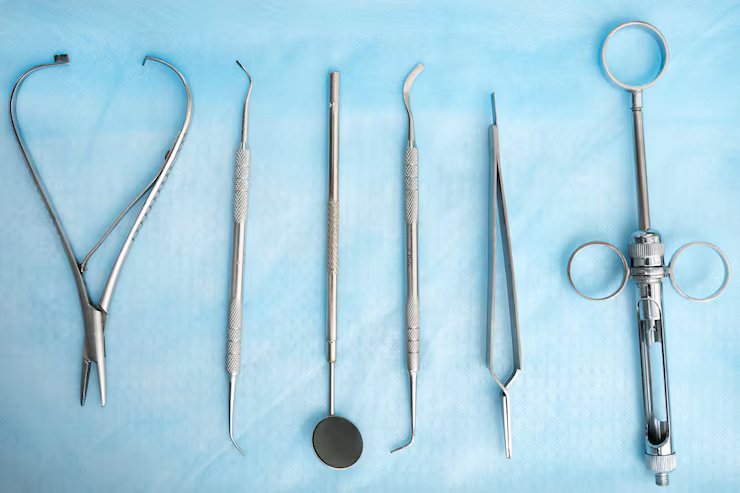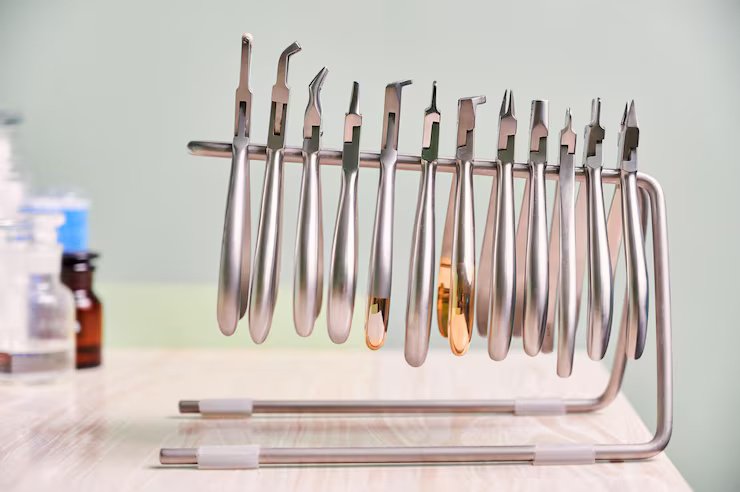Starting or upgrading a dental clinic requires significant investment in reliable, high-quality dental equipment. Understanding the different types of dental tools and equipment used in modern dentistry is essential not only for delivering excellent patient care but also for ensuring operational efficiency and safety. From dental diagnostic tools to surgical instruments, sterilization units, and digital technology, every component plays a vital role.

In this guide, we’ll explore the essential types of dental equipment, their functions, and how they contribute to clinical success. Whether you’re setting up a new practice, upgrading your operatory, or expanding your services, this comprehensive breakdown of dental equipment types will help you make informed decisions.
1. Dental Diagnostic Equipment
Accurate diagnosis is the foundation of effective treatment. Dental diagnostic tools help dentists identify oral health issues at an early stage.
Common Diagnostic Tools:
- Dental Mirrors: Used for indirect vision and retraction.
- Probes and Explorers: Detect cavities and calculus.
- Digital X-ray Machines: Provide detailed imaging of teeth and jaw.
- Intraoral Cameras: Enhance patient education with real-time visuals.
- Cone Beam Computed Tomography (CBCT): Offers 3D imaging for complex diagnoses.
Digital dental diagnostic equipment like CBCT and intraoral scanners are revolutionizing modern dentistry, offering precision and reducing the need for invasive procedures.
External Resource: American Dental Association – Diagnostic Technology
2. Dental Chair Units
The dental chair unit is the centerpiece of every operatory. It must offer comfort, ergonomics, and integration with various tools.
Features to Consider:
- Ergonomic design for patient comfort
- Adjustable height and tilt
- Built-in spittoons and suction
- LED light attachments
- Integration with handpieces and X-ray sensors
High-quality dental chair units also improve dentist posture and workflow. Brands like A-dec, Belmont, and Midmark offer customizable configurations for various specialties.
3. Dental Hand Instruments
Dental hand instruments are manual tools used in virtually every procedure. They are typically categorized based on their function: cutting, examination, restorative, or surgical.
Essential Hand Instruments:
- Scalers and Curettes: Used for cleaning and periodontal treatment
- Excavators: Remove decayed material
- Pluggers and Burnishers: Assist in restorative work
- Tweezers and Forceps: Handle small items
Investing in stainless steel or titanium tools ensures durability and compliance with sterilization standards.
4. Dental Operatory Equipment
The operatory is the heart of your clinic. Aside from the chair, it includes the tools and tech used daily during patient treatments.
Essential Operatory Equipment:
- LED Operating Light: Enhances visibility
- High- and Low-Speed Handpieces: Crucial for cavity preparation and polishing
- Saliva Ejectors and Suction Units: Maintain a dry field
- Air-Water Syringes: For rinsing and drying
- Ultrasonic Scalers: For plaque and tartar removal
Properly outfitting your operatory improves workflow and patient throughput.
5. Dental X-Ray Machines
Dental X-ray machines are indispensable for diagnosing issues below the surface, such as root problems, bone loss, or impacted teeth.
Types of Dental X-rays:
- Intraoral X-rays (bitewing, periapical)
- Extraoral X-rays (panoramic, cephalometric)
- Digital X-rays: Reduced radiation, faster processing
- CBCT Scanners: Ideal for implant planning and orthodontics
Digital radiography is quickly replacing traditional film, offering speed, lower radiation, and easier storage.
External Resource: NIH: Digital Radiography in Dentistry
6. Sterilization Equipment in Dentistry
Infection control is non-negotiable. Sterilization equipment in dentistry is crucial for preventing cross-contamination.
Sterilization Tools:
- Autoclaves (steam sterilizers)
- Dry Heat Sterilizers
- Ultrasonic Cleaners
- Sealing Machines: For sterile pouching
- Washer-Disinfectors
Proper sterilization also ensures compliance with regulatory bodies like OSHA and CDC. A well-organized sterilization area boosts safety and workflow efficiency.
7. Dental Surgical Equipment
Dental surgical equipment is required for procedures like extractions, implants, and periodontal surgeries.
Key Surgical Tools:
- Surgical Elevators and Forceps
- Bone Files and Rongeurs
- Implant Kits and Surgical Motors
- Electrosurgery Units
- Surgical Suction Systems
Dental surgeries demand precision tools made of medical-grade materials. It’s also critical to maintain these tools with strict sterilization protocols.
8. Dental Lab Equipment
Many dental clinics have an in-house or attached dental laboratory for quicker turnaround of prosthetics, crowns, and aligners.
Essential Dental Lab Equipment:
- Casting Machines
- Dental Lathes
- Vibrators
- Vacuum Forming Machines
- 3D Printers and CAD/CAM Systems
Dental lab equipment allows clinics to offer faster, customized solutions with fewer visits. Digital integration (like CAD/CAM) is increasingly popular in modern labs.
External Resource: Digital Dentistry and CAD/CAM Workflow
9. Dental Hygiene Tools
Hygienists use a variety of dental hygiene tools for cleaning, scaling, and polishing.
Core Tools:
- Ultrasonic Scalers
- Hand Scalers and Curettes
- Polishing Cups and Brushes
- Fluoride Trays
- Periodontal Probes
These tools support preventive care, patient education, and long-term oral health maintenance.
10. Portable Dental Equipment
Portable dental equipment is essential for mobile clinics, rural dental care, and emergency relief situations.
Common Portable Units:
- Portable Dental Chairs
- Mobile X-ray Units
- Handheld Ultrasonic Scalers
- Self-contained Delivery Units
- Battery-powered Curing Lights
This equipment is compact, lightweight, and designed for mobility without sacrificing functionality.
External Resource: WHO – Mobile and Portable Dental Systems
11. Digital and Smart Dental Equipment
Technology is redefining what it means to run a modern dental clinic. The latest dental technology and equipment types include:
- AI-enabled Diagnostic Tools
- Laser Dentistry Units
- Digital Impressions and Intraoral Scanners
- 3D Printing for Aligners and Dentures
- Teledentistry Platforms
These tools enhance accuracy, reduce chair time, and improve patient outcomes—important for staying competitive in 2025 and beyond.
12. Setting Up a Dental Clinic: What You Need
If you’re opening a new clinic, you need a comprehensive list of essential dental equipment for new dental clinics.
Starter Equipment Checklist:
- Dental chair unit with light
- X-ray system with digital sensor
- Sterilization system (autoclave, ultrasonic cleaner)
- Air compressor and suction unit
- Basic hand instruments set
- Operatory cabinetry
- Computer system with dental software
You should also factor in cost of dental equipment for small clinics, which can range from ₹15–₹50 lakhs depending on quality, brand, and features.
13. Specialty Equipment for Orthodontists and Endodontists
Different specialties require dedicated tools. Here are examples of types of dental equipment used by orthodontists and other specialists:
For Orthodontics:
- Bracket placement tools
- Orthodontic pliers
- Band pushers and separators
- Intraoral scanners
- Retainer and aligner forming machines
For Endodontics:
- Apex locators
- Endo motors
- Obturation systems
- Root canal files
- Dental microscopes
Choosing the best dental equipment for general dentistry vs. specialized care depends on your clinical focus and patient base.
14. Factors to Consider Before Buying Dental Equipment
Investing in dental tools is a long-term decision. Consider the following:
Key Factors:
- Durability and Brand Reputation
- After-Sales Support
- Integration with Digital Systems
- Regulatory Compliance
- Patient Comfort and Ergonomics
- Energy Efficiency
Buying from reputed suppliers ensures equipment longevity and minimizes maintenance costs.
15. Maintenance and Sterilization Protocols
Proper care extends equipment life and ensures safety.
Best Practices:
- Clean instruments immediately after use
- Follow manufacturer’s sterilization guidelines
- Perform regular calibration on digital equipment
- Document and track maintenance
Maintaining your dental sterilization equipment types and uses log is also crucial for audit readiness and accreditation.
FAQs
Q. What are the different types of dental instruments?
A: These include diagnostic tools (mirrors, probes), hand instruments (scalers, excavators), surgical tools (forceps, elevators), and advanced digital tools like intraoral scanners.
Q. How much does dental equipment cost for small clinics?
A: Basic setups can range from ₹15 lakhs to ₹50 lakhs, depending on the brands and specialization.
Q. Which dental equipment is essential for general dentistry?
A: A dental chair unit, hand instruments, X-ray machine, suction unit, and sterilization setup are must-haves.
Q. What is the latest dental equipment in 2025?
A: AI-enabled diagnostics, laser units, and digital 3D printing are trending in modern dentistry.
Conclusion
Understanding the different types of dental equipment used in clinics is essential for delivering quality care, improving efficiency, and staying competitive. Whether you’re starting out or upgrading your operatory, selecting the right mix of dental diagnostic tools, hand instruments, X-ray machines, and sterilization equipment in dentistry will lay the foundation for a successful practice.
Staying informed about latest dental technology and equipment types ensures your clinic offers modern, patient-centered care. From basic tools to digital systems, the right investment in dental equipment today will yield long-term rewards.



